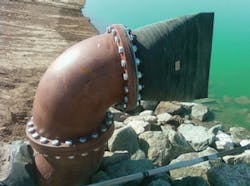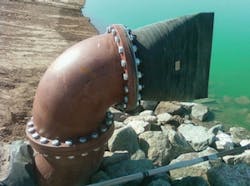Recent Developments in Monitoring Equipment Allow For More Reliable Data and Remote Access
By Sean Porter
Many monitoring programs require estimates of pollutant levels in discharges to receiving waters, especially Total Maximum Daily Loads (TMDL) studies or Daily Average (DA) calculations. These estimates typically satisfy requirements in state Industrial Stormwater Permits. For accurate estimates, rainfall data, instantaneous flow data, and analytical samples must be collected. The samples are usually collected 24-7, with the exception of holidays. However, some industrial sampling programs require sampling during the facility’s operating hours, which could be 8 a.m. to 5 p.m., Monday through Friday.
You can choose from several sampling approaches to complement the study design, satisfy any financial constraints, and ensure data quality. You might even decide to collect water quality data in real time. Data collected can include pH, conductivity, temperature and more.
Loads are typically calculated by estimating a storm’s Event Mean Concentration (EMC) and multiplying that by the total storm volume. The EMC for a runoff event is often provided for selected constituents. Some industrial stormwater programs do not require load calculations but rather Daily Average (DA) samples. These are a combination of samples collected over some time frame or a combination of samples collected from different areas. When combined and analyzed, the result will allow for an accurate DA calculation.
One popular sampling strategy used by many stormwater agencies for load calculations is flow-weighted composite sampling. This strategy generates a storm EMC by combining individual samples into a large (multiple liters borosilicate) sample container. This is a flow-weighted or volume-paced method that uses a flowmeter and automated sampler. When a specified volume has passed the monitoring point, the flowmeter triggers the automated sampler to draw a small sample (50 mL - 500 mL) known as an aliquot. The sampler draws aliquots at specified intervals. At high flow rates, aliquots are taken more frequently and together make up the flow-weighted composite sample. Done this way, the sample is “weighted” towards the higher flow rates.
One of the challenges with collecting a flow-weighted sample is estimating the volume-to-sampler pacing for each storm event. If the pacing is too low and there is more rainfall than expected, the automated sampler will collect samples too frequently and overfill the bottles. If the pacing is too high and less than expected rainfall occurs, the automated sampler may not collect enough aliquots to accurately reflect the event and the sample won’t meet the laboratory volume requirements. Sending field crews out to make last minute pacing changes is costly and potentially dangerous.
Remote Data Systems
Modern stormwater monitoring stations are equipped with flowmeters, water quality probes, autosamplers, solar panels, as well as telemetry devices or web-enabled flowmeters that can be queried to retrieve data. They can also be programmed remotely. This means unexpected rainfall accumulation estimates can be accounted for with last-minute pacing changes. The equipment is typically housed in small weatherproof enclosures.
Several flow monitoring and sampling equipment manufacturers now offer phone- or web-enabled options. To access the flowmeter remotely, you simply “dial” the flowmeter modem with a PC fitted with an analog 56K baud modem over a telephone landline. For example, the ISCO 2105c/g Cellular Interface Module and the Hach Sigma 1000 offer these capabilities. Your PC connects wirelessly to the flowmeter to allow you to download data or make programming changes. The ISCO system can even be programmed to dial out and push data to a server. The server could host the data on a custom website, but programming or sampler pacing changes must be done through the dial-up connection.
You can also use web-enabled flowmeters such as the Telog RU33 and the Hach FL900. The FL900 uses the Internet to connect to and program the flowmeter using packet-based information. These monitoring systems offer a newer form of data transmittal and web control since all programming changes, data upload frequency, alarm conditions, and sampler controls are available from the website. You don’t have to dial the flowmeters. Another advantage is that these automated systems plug-and-play with existing flowmeters, autosamplers, and water quality monitoring probes.
Hach FL900 flowmeters come equipped with the FSDATA™ system and can be connected via cable to autosamplers, rain gauges, and solar panels. This system was designed for large-scale monitoring programs where flowmeters and automated stations are connected to and programmed from a web-based server. The real-time data and programming capabilities are also available to 3G and 4G smart phones, and to non-smart cellular phones via text messaging. This system can reduce labor by 30 to 40 percent, increase safety, allow field crews to respond quickly to equipment failures, and improve sample accuracy.
Web-enabled flowmeters can automatically push data to the server as often as every five minutes. They can also display the real-time status of each monitoring station and alert field crews of failures to automated sample collection equipment. Implementing a system like this creates a Remote Stormwater Data System (RSDS) that allows integrated, remote access to every monitoring station from any Internet-ready location in the world. That means fewer staff members are needed to collect samples — and a significant reduction in costs.
The system allows for Short Message Service (SMS), also referred to as texts, which can be used to deliver alarms and updates. For example, field crews can send SMS messages to the flowmeter requesting the current status. The flowmeter would then respond with battery voltage, current flow rate and rainfall totals.
For projects where there are financial constraints, it may be advantageous to rent equipment rather than buy. The Hach system, for example, offers Data Delivery Services (DDS). With DDS, you pay only for flow data. You don’t have to purchase or maintain the flowmeters. The flowmeters are installed by certified personnel and, for a fixed monthly fee, you have access to your unedited flow data from any web browser via a password-protected site with advanced data security. A system like this is best used with a long-term constant flow monitoring program.
Collecting flow-weighted composite stormwater samples is a challenge due to the technical nature of the programs, the schedule, and estimating the volume-to-sampler pacing for each unpredictable storm event. Modern stormwater monitoring equipment, web-enabled flowmeters and autosamplers can ease the pain by minimizing last-minute changes made on-site by field crews. These systems can also be quickly queried, reducing dry weather maintenance and download times.
Collecting DA samples can also be challenging due to the constraints established by the Industrial Stormwater Permit. Using automated equipment for DA programs can also improve the quality and reliability of the data. As we move into the future, expect automated monitoring equipment to become more compact, sophisticated and user friendly — and provide access to even more data.
WW
About the Author: Sean Porter specializes in stormwater services with a background in monitoring urban land use and natural landscapes, watershed studies, and small catchments. His 16 years’ experience includes designing and implementing large-scale water quality and sediment monitoring programs for regional stormwater monitoring programs for state, municipal, transportation, and federal clients.
More WaterWorld Current Issue Articles
More WaterWorld Archives Issue Articles






